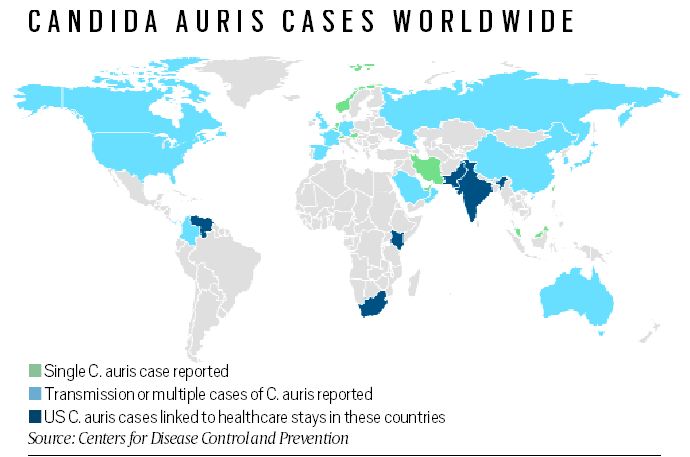International media has been abuzz this week with reports of a mystery infection so tenacious that, The New York Times reported, a top American hospital had to rip out ceiling and floor tiles to get rid of the infestation in the room of a patient after his death. The killer germ, a fungus called Candida auris, has showed up in countries as far apart as Australia and Canada, Venezuela and Japan, over the past few years. It has set alarm bells ringing because it is often resistant to multiple anti-fungal drugs.
Candida auris
The US Centers for Disease Control and Prevention (CDC) describes Candida auris as “an emerging fungus that presents a serious global health threat”, and has sent severely ill patients to hospital in countries including Australia, Canada, China, France, Germany, India, Israel, Japan, Kenya, Kuwait, Oman, Pakistan, Russia, Saudi Arabia, Singapore, South Africa, South Korea, Spain, Venezuela, the UK, and the US. “Patients can remain colonised with C. auris for a long time and C. auris can persist on surfaces in healthcare environments. This can result in spread of C. auris between patients in healthcare facilities.”
That C. auris is difficult to identify with standard lab methods may have had a role to play in the development of its resistance. Healthcare personnel oblivious to it for long continue to prescribe antibiotics — giving the organism time to acclimatise to the medication. C. auris is known to cause outbreaks in hospitals, where it finds vulnerable individuals.
Not quite new
The current panic notwithstanding, the fungus has been around for at least a decade. It was identified in 2009 from yeast isolates from the ear of a Japanese patient, and described as a new species after RNA sequencing. In 2013, a team of Indian scientists led by those from the Vallabhbhai Patel Chest Institute, Delhi, documented in Emerging Infectious Diseases “the emergence of a new clonal strain of C. auris as an etiologic agent of candidemia in India”.

In 2017, the same team of researchers predicted that going by the behaviour of other similar organisms that have developed resistance, a Candida outbreak might be on the cards. “What we do know is that environmental factors probably play a role in outbreaks in healthcare settings that include prolonged survival in healthcare environments, probably due to skin colonization of patients and asymptomatic carriers… A further spread of C. auris in healthcare settings on a worldwide scale is expected,” the researchers, led by Dr Anuradha Chowdhary of the Department of Medical Mycology, Vallabhbhai Patel Chest Institute, wrote in PLOS Pathogens.